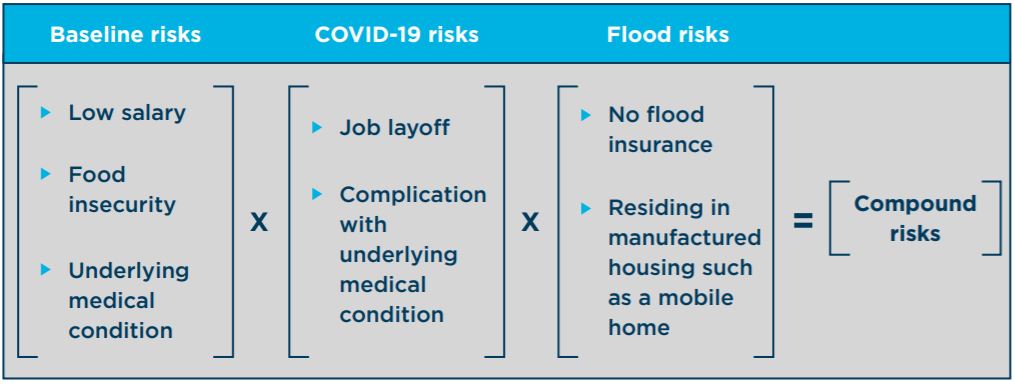

Hurricane season is upon us in North Carolina, pandemic or not, and preparations for extreme weather look different this year.
Even as the North Carolina Department of Health and Human Services continues to report more COVID-19 cases and deaths in our state, researchers at North Carolina State University have predicted that the 2020 Atlantic hurricane season will feature 18-22 named storms.
When Hurricane Isaias approached North Carolina in early August, the American Red Cross told residents to avoid shelters except as a last resort, in order to limit the spread of coronavirus in crowded indoor spaces. This new directive was distressing and confusing for many residents and operators of safety net organizations, but it was emblematic of how preparing for extreme weather is different during a pandemic.
PPE and Sheltering During a Storm
In March, the office of Governor Roy Cooper created a Task Force for Emerging Repurposing of Manufacturing (TFERM) to identify and manage personal protective equipment across the state, and repurpose some of North Carolina’s historic manufacturing facilities for that purpose. TFERM has gathered or facilitated the production of millions of face shields, gloves, and other PPE since, prioritized first for groups encountering COVID cases on a regular basis. In an emergency such as a hurricane, this will likely include first responders and medical staff, with shelters or other facility staff in the second priority group, according to TFERM.
Brad Ives, director of TFERM, said in a recent webinar that shelters’ best practice is to have 115 square feet per person. Previously, that meant the average shelter could house 600 people. Now, with social distancing needs, that same shelter can only house about 235 people.
“Shelters now need to be viewed as a last resort,” Ives said, noting that people seeking shelter will have to bring their own bedding, as no cots are available under new restrictions.
According to Ives, the North Carolina Department of Emergency Management has identified 30,000 non-congregate living spaces such as hotels and dormitories, and will encourage people to evacuate areas expected to be hit by hurricanes ahead of time to find appropriate shelter.
Managing Extreme Heat
In addition to hurricanes and flooding events, late summer often means extreme heat in North Carolina, and with extreme heat can come heat-related illness and deaths. Though North Carolina does not have a statewide system of cooling centers, some cities – such as Charlotte and Fayetteville – offer them for people who do not have access to air conditioning. Coronavirus has already begun to complicate this service, as social distancing is difficult, if not impossible, at such centers. The CDC released guidance for cooling centers in April, but not all centers have the resources to follow these guidelines, and have had to close.
For individual households, North Carolina participates in the Crisis Intervention Program, a federally funded program that helps eligible households with heating or cooling needs. Eligibility requires risk of a life-threatening or health-related emergency without access to cooling, and inability to receive assistance from another source. Applications for CIP in North Carolina opened and closed in June
Households at or below 200% of federal poverty guidelines may be eligible for weatherization services through the U.S. Department of Energy that may also help with cooling and home resilience to extreme weather, and energy companies like Duke Energy also offer some cooling assistance to eligible customers.
Vulnerable Communities
Raleigh is expected to see 81 days with a heat index over 100 degrees annually by the end of this century, contributing not only to heat-related illness and death but also to sea level rise and severe weather impacts. Communities living close to chemical facilities, hog farms, and other flood-prone bodies of water are also some of the same communities suffering most from the COVID-19 pandemic: communities with a high percentage of low-income minority populations will also suffer most acutely from the health impacts of extreme weather, which in turn contribute to the socioeconomic factors that made them vulnerable. Low-wage minority workers do much of the “essential” work that has put them at risk for COVID-19; they also do the bulk of recovery work after a weather disaster.

Regardless of how long the COVID-19 pandemic lasts, recovery will likely be lengthy, increasing the likelihood of weather emergencies in communities that are already struggling. During a recent webinar about climate change and COVID-19 hosted by the Union of Concerned Scientists, senior climate scientist Astrid Caldas said, “Climate adaptation and resilience measures must include both economic and COVID recovery.”
According to Ives, the North Carolina Department of Emergency Management is currently conducting a $2 million study on flooding and resiliency in Eastern North Carolina. The aim is to identify areas that will suffer most from increased flooding in the coming years – many of them communities with additional vulnerabilities – and decide where to “pre-position” backup PPE and other supplies.
In the meantime, ReadyNC.org has advice for all North Carolina residents preparing for a hurricane or other disaster, including:
• making a plan to stay with family or friends inland instead of evacuating to a shelter, and
• including masks, hand sanitizer, cleaning products, and sanitizing wipes in emergency supply kits.
The September/October 2020 issue of the North Carolina Medical Journal will cover the impact of a changing climate on public health in North Carolina, including extreme weather, vector-borne diseases, behavioral health concerns, and weatherization.